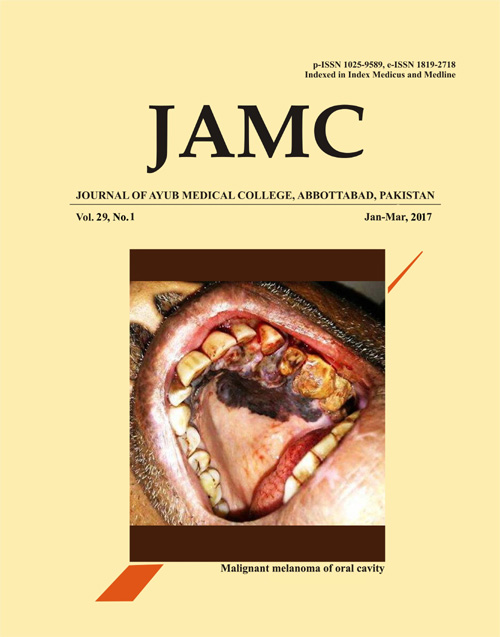GLYCEMIC CONTROL OF TYPE 2 DIABETIC PATIENTS DURING RAMAZAN FASTING
Abstract
Background: Among five main pillars of Islam Fasting is one of the key elements, all healthy adult Muslims have to observe fast from dawn till dusk during the holy month of Ramadan. According to a 2009 demographic study, Islam has 1.57 billion believers, making up 23% of the world population of 6.8 billion, and is growing by 3% per year. EPIDIAR (epidemiology of diabetes and Ramadan) study showed that 43% patients with type 1 and 79% patients with type2 diabetes observe fast during the month of Ramadan. Whereas those people who are suffering from diabetes and are fasting may be at risk of adverse outcomes and the risks may rise with longer fasting periods. Ideal management of diabetic patients who wish to fast during Ramadan needs to be done to avoid the complications. The purpose of this study was to observe the effect of fasting on glycaemic control in type 2 diabetic patients during the month of Ramadan. Methods: This was an observational cross sectional study; it was conducted at outpatient department Jinnah institute of diabetes and endocrinology Jinnah hospital Lahore during the month of Ramadan. Patients were advised to monitor blood sugar levels for two days before and after three meals (lunch, breakfast and dinner) before Ramadan and then during Ramadan blood sugar levels were monitored for four days in first Ashra before and two hours after Sehari, for four days at noon during second Ashra and then for four days pre and two hours after Iftar in last Ashra of Ramadan. Patients were educated Pre-Ramadan about glucose monitoring and drug dosage adjustments were done along with dietary counselling. Results: Blood glucose levels two days before and during Ramadan fell within range of mean glucose level of 150–187 mg/dl showing no extreme fluctuations in blood glucose levels only one patient reported symptomatic and biochemical hypoglycaemia severe enough to break the fast at noon. Conclusion: We concluded that in Ramadan fasting, type 2 diabetic patients with proper education, dietary counselling and drug dosage adjustments glycaemic control can remain in safe acceptable range preventing any life-threatening complication.Keywords: Type 2 Diabetes; Fasting; Ramadan; Glycaemic controlReferences
The Canadian Society of Muslims: Muslim population statistics [Internet]. 2000 [cited 2005 April 14]. Available from: http://muslim-canada.org/muslimstats.html
Wild S, Roglic G, Green A, Sicree R, King H. Global prevalence of diabetes, estimates for the year 2000 and projections for 2030. Diabetes Care 2004;27(5):1047–53.
Khaled BM, Belbraouet S. Effect of Ramadan fasting on anthropometric parameters and food consumption in 276 type 2 diabetic obese women. Int J Diabetes Dev Ctries 2009;29(2):62–8.
Guariguata L, Whiting D, Weil C, Unwin N. The International Diabetes Federation diabetes atlas methodology for estimating global and national prevalence of diabetes in adults. Diabetes Res Clin Pract 2011;94(3):322–32.
Salti I, Benard E, Detournay B, Bianchi-Biscay M, Le Brigand C, Voinet C, et al. A Population-Based Study of Diabetes and Its Characteristics During the Fasting Month of Ramadan in 13 Countries Results of the Epidemiology of Diabetes and Ramadan 1422/2001 (EPIDIAR) study. Diabetes care 2004;27(10):2306–11.
Hui E, Bravis V, Hassanein M, Hanif W, Malik R, Chowdhury T, et al. Management of people with diabetes wanting to fast during Ramadan. BMJ 2010;340:c3053.
Uysal A, Erdoğan MF, Sahin G, Kamel N, Erdoğan G. Clinical and metabolic effects of fasting in 41 type 2 diabetic patients during Ramadan. Diabetes care 1998;21(11):2033–4.
Al-Arouj M, Bouguerra R, Buse J, Hafez S, Hassanein M, Ibrahim MA, et al. Recommendations for management of diabetes during Ramadan. Diabetes care 2005;28(9):2305–11.
Bogdan A, Bouchared B, Touitou Y. Ramadan fasting alters endocrine and neuroendocrine cicardian patterns. Meal-time as a synchronizer in humans? Life Sci 2001;68(14):1607–15.
Kassab S, Abdul-Ghaffar T, Nagalla DS, Sachdev U, Nayar U. Interactions between leptin, neuropeptide-Y and insulin with chronic diurnal fasting during Ramadan. Ann Saudi Med 2004;24(5):345–9.
Sadiya A, Ahmed S, Siddieg HH, Babas IJ, Carlsson M. Effect of Ramadan fasting on metabolic markers, body composition, and dietary intake in Emiratis of Ajman (UAE) with metabolic syndrome. Diabetes Metab Syndr Obes 2011;4:409–16.
Sari R, Balci MK, Akbas SH, Avci B. The effects of diet, sulfonylurea, and Repaglinide therapy on clinical and metabolic parameters in type 2 diabetic patients during Ramadan. Endocr Res 2004;30(2):169–77.
Ahmedani M, Alvi SF, Haque MS, Fawwad A, Basit A. Implementation of Ramadan-specific diabetes management recommendations: a multi-centered prospective study from Pakistan. J Diabetes Metab Disord 2014;13(1):37.
Published
Issue
Section
License
Journal of Ayub Medical College, Abbottabad is an OPEN ACCESS JOURNAL which means that all content is FREELY available without charge to all users whether registered with the journal or not. The work published by J Ayub Med Coll Abbottabad is licensed and distributed under the creative commons License CC BY ND Attribution-NoDerivs. Material printed in this journal is OPEN to access, and are FREE for use in academic and research work with proper citation. J Ayub Med Coll Abbottabad accepts only original material for publication with the understanding that except for abstracts, no part of the data has been published or will be submitted for publication elsewhere before appearing in J Ayub Med Coll Abbottabad. The Editorial Board of J Ayub Med Coll Abbottabad makes every effort to ensure the accuracy and authenticity of material printed in J Ayub Med Coll Abbottabad. However, conclusions and statements expressed are views of the authors and do not reflect the opinion/policy of J Ayub Med Coll Abbottabad or the Editorial Board.
USERS are allowed to read, download, copy, distribute, print, search, or link to the full texts of the articles, or use them for any other lawful purpose, without asking prior permission from the publisher or the author. This is in accordance with the BOAI definition of open access.
AUTHORS retain the rights of free downloading/unlimited e-print of full text and sharing/disseminating the article without any restriction, by any means including twitter, scholarly collaboration networks such as ResearchGate, Academia.eu, and social media sites such as Twitter, LinkedIn, Google Scholar and any other professional or academic networking site.









